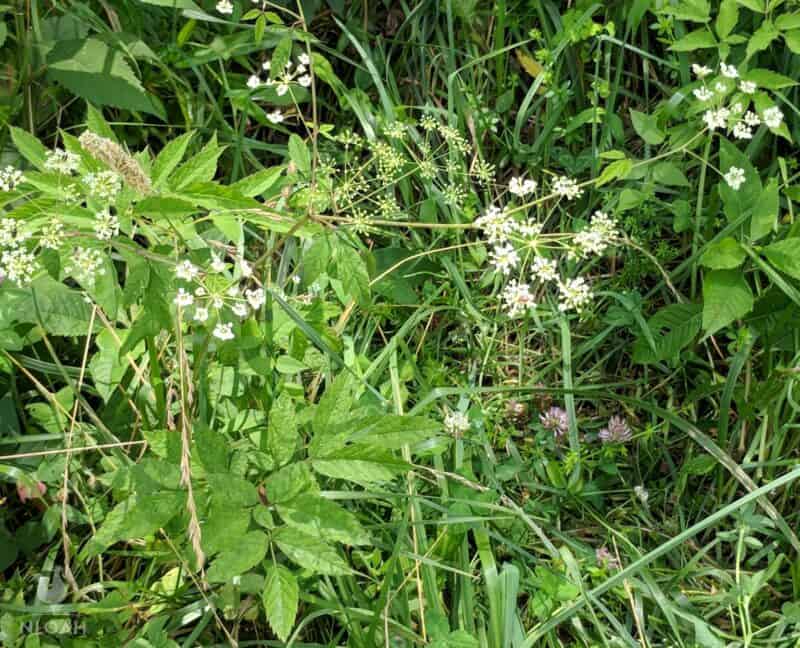When I was a kid, my parents used to take us out on hiking trails almost every weekend. I was also a cub scout for a few years, and so I spent a lot of time in nature reserves on hiking trails.

One thing that I learned every quickly was: leave. plants. alone. This is something that can get rookie hikers into serious trouble.
Poison hemlock is one of the many plants that can cause a lot of trouble; but is it deadly?
Yes, poison hemlock is very deadly. The toxins it contains can cause dermatitis, respiratory and organ failure, and death. A lethal dose for adult humans is between 150 and 300 mg, but hemlock poisoning can result from much smaller doses. Poison Hemlock is highly toxic, and the lack of an antidote often makes extreme cases of hemlock poisoning fatal.
What is Poison Hemlock?
Poison hemlock is a highly poisonous plant in the carrot family that’s native to Europe and North Africa. This is a very hardy plant, and can survive in a variety of environments like Australia, Asia, and other places. It can spread quickly and so it’s classified as an invasive weed.
Every part of the plant is highly toxic; the seeds and roots are particularly toxic – especially if you eat them. These plants have a rather unpleasant odor, and can grow up to 9 feet (2.7 meters).
It Causes Neurological Chaos
Poison Hemlock contains a toxin called coniine which, even in small amounts, can be lethal – to all mammals (or really anything that eats it). Poisoning usually comes from ingestion, a lethal dose for adult humans is between 150 and 300 mg, but even a smaller dose can be nasty.
It can also occur through skin contact and inhalation. If your skin touches poison hemlock it can cause irritation and a rash. Inhalation usually comes from improperly trying to deal with these pesky plants by cutting them. When you cut / mow through poison hemlock, it releases poisonous fumes – this is also why you don’t burn the plant.
The coniine affects the central nervous system by inhibiting nicotinic receptors. It can also affect the kidneys by constricting the bladder leading to urine accumulation (lovely). Additionally, there are also other alkaloids which cause chaos with your body’s temperature regulation leading to hypothermia and an increased heartrate.
To date, as far as I can find, there is no antidote for hemlock poisoning.
Symptoms and First Aid
- Symptoms of Hemlock poisoning include:
- Dilated pupils
- Irregular heart rate
- Muscular pain, weakness, or paralysis
- Convulsions
- Trembling
- Loss of speech
- Respiratory failure
- Kidney failure
- Unconsciousness
- Death
While there is no antidote available for hemlock poisoning, there are a few things that can be done to treat it. Now, treatment depends on the severity of the symptoms you’re experiencing.
Artificial respiration may be used to prevent death and, assuming that you weren’t exposed to a fatal amount of poison hemlock, and you avoid further exposure; the poison should work its way out of your system within 72 hours.
Proper disposal of the plants through the use of herbicides, digging up the seedlings (carefully), and preventing the pest from returning are good ways to prevent poisoning.
Lookalikes sometimes result in Accidental Poisoning
Now, you’re probably wondering: “why would anyone eat this plant if it’s so dangerous?”
The answer is simple: it’s accidental. The roots are commonly mistaken for parsnips, and its leaves are mistaken for parsley – which is how it’s also called ‘poison parsley’ in some places. Other lookalikes include:
- Wild carrot
- Pacific water parsley
- Wild and Bur Chervil
- Fennel
- Anise
- Coltsfoot
So, most of the time, poisoning comes from people mistaking poison hemlock for something edible and chowing down – often with fatal consequences.
The Bottom Line: Leave it ALONE!
To recap:
- Yes, poison hemlock is deadly.
- It causes respiratory and organ failure among other problems.
- Cutting it causes the plant to give off poisonous fumes.
- There is a slim chance of survival assuming that the initial exposure wasn’t lethal and further exposure is avoided.
- There are lookalike plants which sometimes cause accidental poisoning.
- There’s no antidote for hemlock poisoning.
The bottom line is if you see this plant: leave it alone. This especially true if you’re not sure of what it is. If you must handle it, use protective gear (gloves, masks, long sleeves, etc.) to remove the weeds and make sure you get the root so that it can’t grow back.
In closing, I’d like to thank you all for reading. I hope you found this article informative, and that you enjoyed reading it. Until next time, take care!

Greg is a South African farmer and homesteader who’s been around animals ever since he can remember. He’s also an avid camper and hiker.

Where does hemlock grow naturally?